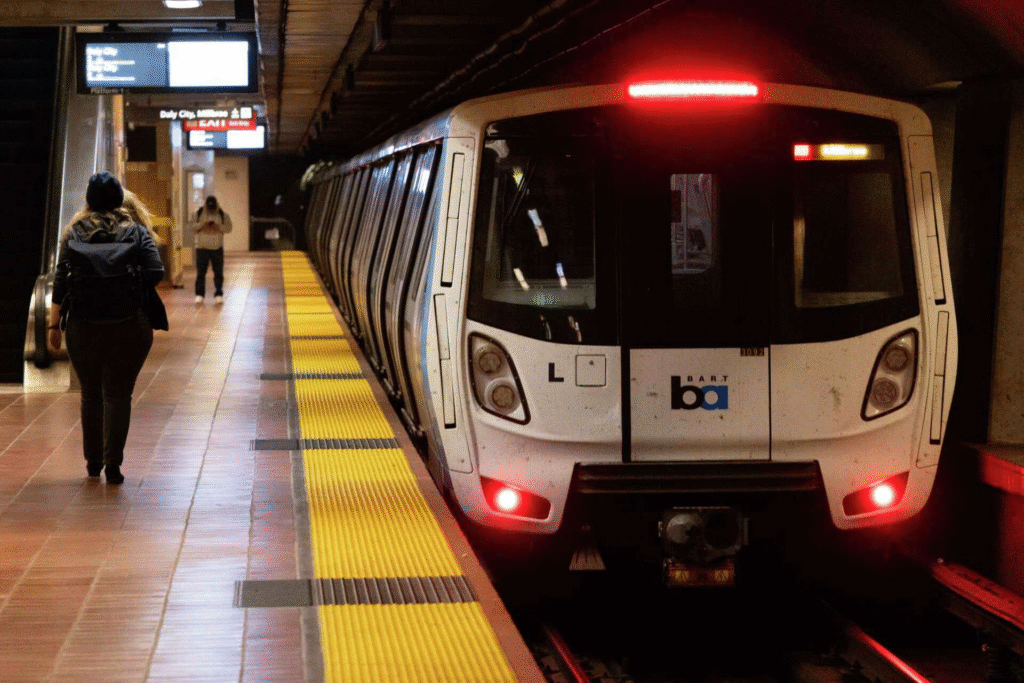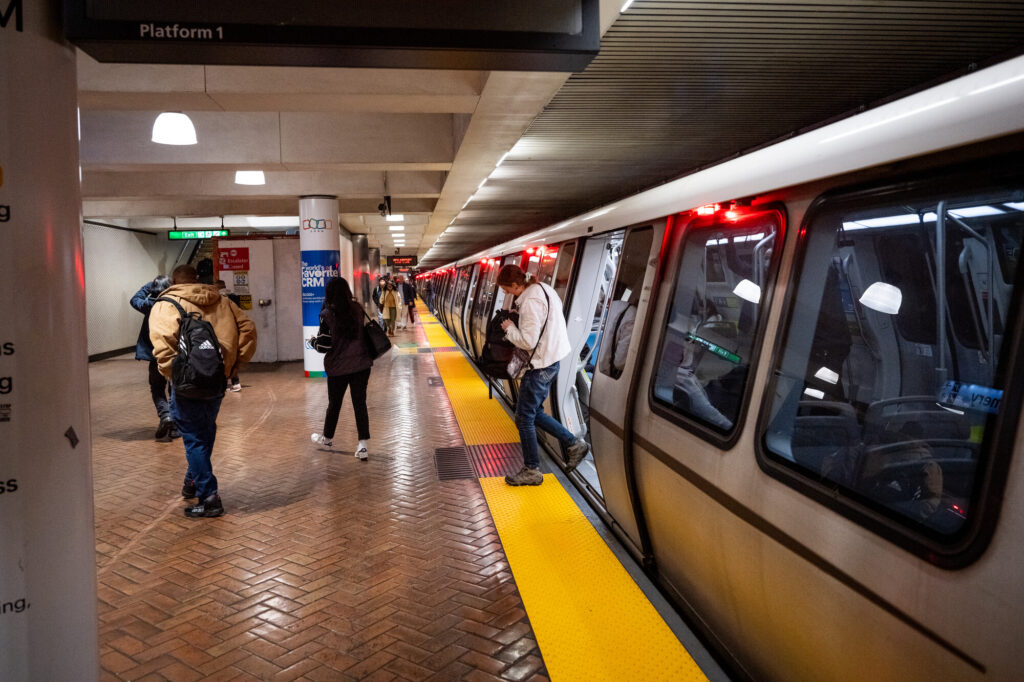
On May 9, 2025, the Bay Area Rapid Transit (BART) system, a crucial lifeline for commuters across the Bay Area, experienced a catastrophic, systemwide shutdown. The failure left thousands of riders stranded, disrupting the morning rush hour and creating significant chaos throughout the region. As one of the most used public transit systems in the United States, BART’s unexpected failure sent shockwaves through the Bay Area, bringing traffic to a standstill and forcing many commuters to scramble for alternative methods of travel.
The BART system’s sudden shutdown, which began early in the morning, was due to a technical malfunction that affected the entire network, spanning from the East Bay to San Francisco. By mid-morning, commuters across the region were left grappling with delays and overcrowded buses. The incident highlighted the fragility of the region’s transportation infrastructure and left many questions about the future of public transit in the Bay Area.
In this comprehensive article, we take a closer look at the events surrounding the BART systemwide shutdown, its impact on Bay Area commuters, the response from transit authorities, and what lessons might be learned to prevent similar occurrences in the future.
A Sudden Crisis: The Morning of May 9, 2025
The morning began just like any other in the Bay Area. The sun rose over the Golden Gate Bridge, and commuters were making their way to the nearest BART stations to catch the trains that would take them to their workplaces, schools, and appointments. For the many who depend on BART as their primary means of transport, it was a familiar and essential part of their daily routine.
But by 6:00 AM, the usual bustle of BART stations across the region came to an abrupt halt. Passengers waiting at platforms found themselves staring at empty tracks as trains failed to arrive on schedule. The usual hum of BART trains running on time was replaced by confusion and frustration as commuters began to realize that something was wrong.
At approximately 6:30 AM, BART officials issued a brief statement confirming that there had been a technical failure impacting the entire system. The announcement sent shockwaves through the Bay Area as it became clear that the transit system, which serves more than 400,000 riders daily, had come to a standstill.
The Cause of the Shutdown: A Critical Failure in BART’s Control System
As news of the BART shutdown spread, commuters were left wondering what had caused the unexpected failure. According to BART engineers, the shutdown was triggered by a malfunction in the central control system, which is responsible for managing the schedules and operations of the trains throughout the entire network. This critical failure disrupted communication between the control centers and the trains, rendering the system inoperable.
The central control system plays a vital role in coordinating the movements of BART trains, ensuring that they run on time and safely navigate the network of tracks. When this system experienced a malfunction, it led to a complete loss of communication between the control centers and the trains, preventing any trains from being dispatched or operating.
Initially, BART officials believed the issue might be a minor glitch that could be resolved quickly. However, as the hours passed and engineers worked tirelessly to fix the problem, it became clear that this was not a simple issue. The failure was complex, and restoring full service would take longer than expected.
By 8:00 AM, BART’s social media channels, website, and app were inundated with angry messages from commuters demanding answers. The lack of transparency during the early stages of the shutdown added to the frustration of the public, who were left without clear updates or timelines for when the system would be operational again.
The Fallout: How the Shutdown Impacted Bay Area Commuters
For Bay Area residents who rely on BART for their daily commute, the shutdown was a major disruption. With trains unable to run, the region’s transportation network was thrown into chaos. People who had planned their entire day around BART’s schedule found themselves stranded, scrambling for alternative ways to get to their destinations.
The timing of the shutdown could not have been worse. May 9, 2025, was a typical weekday morning, and BART’s usual rush hour carried tens of thousands of riders across the Bay Area. Many commuters were heading to work or school, and missing or being delayed on their trains meant they risked being late for critical appointments. As more riders arrived at stations and realized that there was no sign of the trains, panic set in, especially for those who had no backup plan in place.
Commuters were left to make split-second decisions on how to get to their destinations. For those who could drive, the increase in car traffic became evident as major roadways, including Interstate 80, Highway 101, and the Bay Bridge, quickly became clogged with cars. Drivers struggled to navigate through heavy traffic, exacerbated by those who had no other options but to rely on their personal vehicles.
For many commuters, the sudden shift to driving also meant missing out on the benefits of BART. The ease and efficiency of the BART system had made it a preferred option for many, allowing them to bypass the often congested roadways. But now, with BART out of service, the alternative was a traffic nightmare. The result was that people who normally relied on BART to avoid traffic found themselves stuck in long lines of cars, trying to make it to their destinations through congested streets.
Alternative Options: The Strain on Public Transit and Ridesharing
As the BART shutdown continued, public transit agencies across the Bay Area were forced to step up in an attempt to alleviate some of the pressure. AC Transit, Golden Gate Transit, and other local bus systems increased service on major routes to help accommodate the influx of commuters looking for alternatives. However, the increase in demand quickly overwhelmed these systems.
Buses, which were already operating at near full capacity, became crowded, and long lines formed at bus stops. Riders reported waiting for multiple buses before being able to board, and even then, many were packed into buses like sardines. The usual comfort and reliability of public transit were replaced with the discomfort of overcrowded conditions and long delays.
The situation worsened as ridesharing services such as Uber and Lyft experienced a surge in demand. Riders who typically relied on BART to get to their destinations now turned to these services as a last resort. However, with the significant increase in demand, the availability of drivers was limited, and surge pricing became the norm. The price of rides soared, and many commuters were forced to pay premium prices just to get where they needed to go.
Meanwhile, cyclists also took advantage of the opportunity to avoid the traffic gridlock, with many turning to bike-share programs like Bay Wheels. Cycling, once a niche option, became more mainstream as commuters opted for bikes to navigate the city streets. But even biking had its drawbacks. With the increased number of riders, local streets became more congested, and cyclists faced traffic dangers, further complicating the situation.
BART’s Response: What Did the Officials Do?
BART officials, aware of the widespread disruption, were quick to provide updates to the public, despite some initial communication breakdowns. They took to social media, issuing updates on the progress of repairs and assuring the public that the system would be restored as quickly as possible.
“We understand the frustration of our riders, and we are working around the clock to resolve this issue,” said Emily Richardson, BART’s Chief Spokesperson, during a mid-morning press conference. “Safety is our top priority, and we cannot resume service until we are absolutely sure that everything is functioning correctly. We ask for your patience as our engineers continue to work.”
However, this message did little to calm the nerves of commuters, who were becoming increasingly impatient. Many riders expressed frustration over the lack of transparency and the absence of a clear timeline for when the trains would begin running again. The hours ticked by, and with each passing minute, more people found themselves unable to make it to work or school on time.
By 10:00 AM, BART was able to provide an update indicating that engineers had successfully resolved the issue with the central control system, but full service would take longer to restore. BART began a gradual return to operations, bringing trains online in stages to ensure safety. While some stations reopened, others remained closed, and the system operated at a limited capacity for the rest of the day.
A Long Road Ahead: Lessons for BART and the Future of Bay Area Transit
By the time the BART system was fully restored by late afternoon, commuters had already faced hours of inconvenience. The impact of the shutdown was clear. Not only had it caused delays and missed appointments, but it had also highlighted some significant weaknesses in the region’s transportation infrastructure.
In the aftermath of the crisis, BART officials announced that they would be conducting a thorough investigation into the root causes of the failure. In addition to this, the agency has committed to investing in upgrading its control systems and communication infrastructure to prevent future failures. The goal is to ensure that any similar incidents can be handled more quickly and with greater transparency.
“We are committed to making improvements to our system,” said BART’s General Manager, Robert T. Doyle. “This incident has shown us where we need to improve, and we are taking immediate action to ensure that something like this never happens again.”
Public transit experts have echoed this sentiment, calling for more modernized systems and better crisis management plans for future disruptions. BART’s failure to effectively communicate with its riders during the shutdown highlighted the need for improved communication strategies, especially during emergencies.
Conclusion: What’s Next for BART and Bay Area Commuters?
The BART systemwide shutdown on May 9, 2025, was a stark reminder of the reliance the Bay Area places on public transit. With BART serving as the backbone of the region’s transportation network, a disruption of this magnitude is a serious concern for both commuters and the agencies responsible for operating the system.
For now, the Bay Area’s commuters can only hope that lessons have been learned from the incident and that BART will take the necessary steps to prevent future disruptions. While the system was eventually restored, the lingering question remains: can BART continue to meet the needs of a growing and increasingly congested region?
As the Bay Area looks to the future, it will be critical for transportation officials to invest in infrastructure improvements, modern technology, and crisis communication strategies that can handle the pressures of a rapidly expanding metropolitan area. The events of May 9, 2025, have shown that when it comes to public transit, preparation, reliability, and transparency are key to ensuring a smooth and efficient service.
For now, the Bay Area’s commuters are left to reflect on the lessons learned from this unexpected shutdown and to hope that the region’s transportation system is better prepared for whatever comes next.

